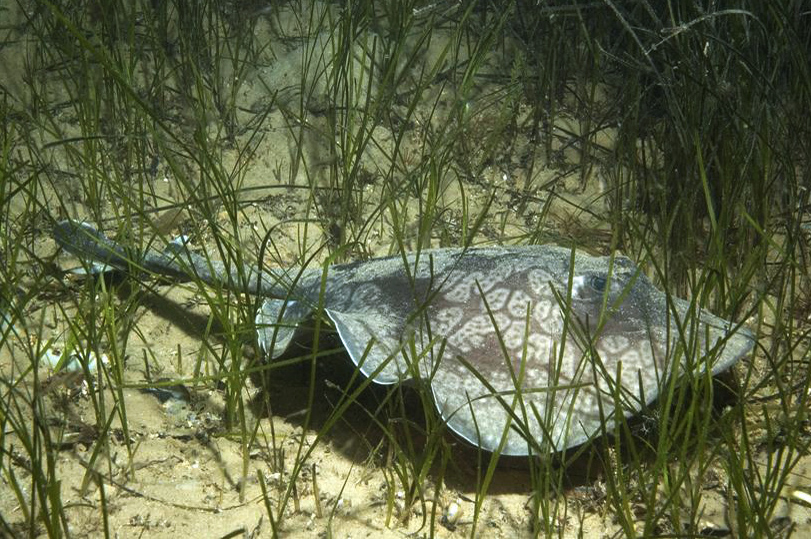Spotted Stingaree, Urolophus gigas Scott 1954
Other Names: Sinclairs Stingaree

A Spotted Stingaree, Urolophus gigas, at St Leonards Jetty, Port Phillip, Victoria, 2005 - depth 5 metres. Source: Jasper Montana / Museums Victoria. License: CC by Attribution
Summary:
A dark brown to blackish stingaree covered with many indistinct pale rings and spots; underside white or cream, margin of disc and tail grey or black.
The spine on the tail behind the dorsal fin is venomous and may cause a very painful wound.
Video of a Spotted Stingaree at Balnarring, Western Port, Victoria.
The spine on the tail behind the dorsal fin is venomous and may cause a very painful wound.
Video of a Spotted Stingaree at Balnarring, Western Port, Victoria.
Cite this page as:
Bray, D.J. 2021, Urolophus gigas in Fishes of Australia, accessed 06 Jul 2025, https://fishesofaustralia.net.au/home/species/3534
Spotted Stingaree, Urolophus gigas Scott 1954
More Info
|
Distribution |
Endemic to southern Australian from about Cape Howe, Victoria, to Albany, Western Australia, including northern Tasmania. Inhabits sandy areas around seagrass beds and shallow rocky reefs at depths to 50 m - often resting partly buried in sand. |
|
Features |
Body extremely depressed; tail rounded in cross-section, moderately short (67-72% disc length), lateral skin folds absent. Disc oval, slightly longer than wide, broadest part immediately behind level of spiracles, anterior edge rounded; snout fleshy, tip rarely extended; eyes small (18-20% of distance between snout tip and middle of lower jaw); posterior margin of spiracles rounded; mouth small, 9-12 papillae on mouth floor; internasal flap skirt-shaped, posterior angle not extended into distinct lobe; posterolateral border of nostrils not extended into distinct lobe and not forming flattened tentacle; five pairs of gill slits on underside of disc. Skin smooth. Dorsal fin present on the tail before the venomous spine; anal fin absent; caudal fin short, deep. |
|
Feeding |
Presumably feeds on benthic invertebrates and fishes. |
|
Biology |
Males mature at 42 cm TL; females at 46 cm TL; reproduction is biennial, with a litter size of 11-13 pups/litter. Females give birth to live young. Stingarees are aplacental viviparous, meaning that the embryos emerge from eggs within the uterus and undergo further development until they are born. After emerging from their egg cases, the embryos are initially sustained by their yolk, and later by histotroph, a "uterine milk" produced by the mother. |
|
Fisheries |
Ocasionally taken by otter trawl and gillnet as bycatch in commercial fisheries in southeastern Australia. |
|
Remarks |
The Spotted Stingaree is often misidentified by divers as the young of the Smooth Stingray (Bathytoshia brevicaudata). |
|
Etymology |
The specific name is from the Greek gigas (= giant), possibly in reference to the large size of this species. |
|
Species Citation |
Urolophus gigas Scott, 1954, Rec. South Aust. Mus. 11(2): 105, pl. 22. Type locality Port Noarlunga, 35°09'S, 138°29'E, South Australia. |
|
Author |
Bray, D.J. 2021 |
|
Resources |
Spotted Stingaree, Urolophus gigas Scott 1954
References
Gomon, M.F., Yearsley, G.K. & Last, P.R. 2008. Family Urolophidae. 125-137 pp. in Gomon. M.F., Bray, D.J. & Kuiter, R.H. (eds) Fishes of Australia's Southern Coast. Sydney : Reed New Holland 928 pp.
Hutchins, J.B. & Swainston, R. 1986. Sea Fishes of Southern Australia. Complete field guide for anglers and divers. Perth : Swainston Publishing 180 pp.
Kuiter, R.H. 1993. Coastal Fishes of South-eastern Australia. Bathurst : Crawford House Press 437 pp.
Kuiter, R.H. 1996. Guide to Sea Fishes of Australia. A comprehensive reference for divers and fishermen. Sydney, NSW, Australia : New Holland Publishers xvii, 434 pp.
Kyne, P.M., Last, P.R. & Marshall, L.J. 2019. Urolophus gigas. The IUCN Red List of Threatened Species 2019: e.T60094A68649513. https://dx.doi.org/10.2305/IUCN.UK.2019-1.RLTS.T60094A68649513.en. Downloaded on 13 June 2021.
Last, P.R. & Gomon, M.F. 1994. Family Urolophidae. pp. 172-181 figs 150-159 in Gomon, M.F., Glover, C.J.M. & Kuiter, R.H. (eds). The Fishes of Australia's South Coast. Adelaide : State Printer 992 pp. 810 figs.
Last, P.R. & Stevens, J.D. 1994. Sharks and Rays of Australia. Canberra : CSIRO Australia 513 pp. 84 pls.
Last, P.R. & Stevens, J.D. 2009. Sharks and Rays of Australia. Collingwood : CSIRO Publishing Australia 2, 550 pp.
Last, P.R., Yearsley, G.K. & White, W.T. 2016. Family Urolophidae. pp. 676-705 in Last, P.R., White, W.T., de Carvalho, M.R., Séret, B., Stehmann, M.F.W. & & Naylor, G.J.P. (eds) Rays of the World. Melbourne: CSIRO Publishing, 800 pp.
Scott, T.D. 1954. Four new fishes from South Australia. Records of the South Australian Museum (Adelaide) 11(2): 105-112 figs 1-3 pl. 22 See ref at BHL
Yearsley, G.K. & Last, P.R. 2016. A new genus of stingarees (Myliobatiformes: Urolophidae) with comments on other urolophid genera and an annotated checklist of species, pp. 35-30 in Last, P.R. & Yearsley, G.K. (eds). Rays of the World: Supplementary Information. Melbourne: CSIRO Publishing, 800 pp.








